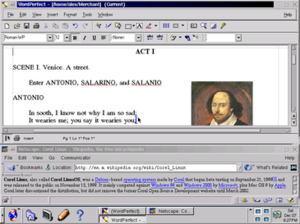Corel Linux
 Screenshot of Corel Linux runningWordPerfectandNetscape Navigator | |
| Developer | Corel |
|---|---|
| OS family | Linux(Unix-like) |
| Working state | Discontinued |
| Initial release | November 15, 1999 |
| Latest release | Second Edition / August 15, 2000 |
| Platforms | IA-32 |
| Kerneltype | Monolithic |
| Default user interface | CDE (variant ofKDE) |
Corel Linux,also calledCorel LinuxOS,was aDebian-basedoperating systemmade byCorelthat began beta testing on September 21, 1999[1]and was released to the public on November 15, 1999. It mainly competed againstWindows 98andWindows 2000byMicrosoft,plusMac OS 9byApple.Corel later discontinued the distribution, but did not remove the former Corel Open Source Development website until March 2002.
Corel did not use KFM, the standardKDEfile manager.It instead used its own file manager, CFM. This, along with other modifications Corel made, made the operating system incompatible with other versions of Linux much more so than other competitors in the industry. At a time when there was relatively little commercial Linux software available, this was a serious hurdle for Corel and its users.
The operating system's Second Edition was released on August 15, 2000, in download, regular and deluxe editions. The latter bundled CorelWordPerfect Officefor Linux.
Xandrospurchased the Corel Linux source code and development team whenCorelscrapped its Linux business in August 2001.
System requirements[edit]
| Minimum | Recommended | |
|---|---|---|
| Processor | Pentium(P5) or compatible/newer | |
| Memory | 24MBofRAM | At least 64 MB of RAM |
| Video adapter and monitor | VGA(640 x 480) or higher resolution with 2 MB ofVRAM | |
| Hard disk drive free space | 500 MB for initial release 800 MB for Second Edition | |
| Optical drive | CD-ROM drive[4](only to install from CD-ROM media) | |
| Input devices | Keyboard,mouse or a compatible pointing device | |
| Sound | Sound cardandSpeakersorheadphones(only for sound playback) | |
Features[edit]
Corel Linux featured a file manager that was very close in look and feel toWindows Explorer.The file manager provided an integrated Windows SMBnetwork browser.The company also advertised that the operating system was compatible with its flagship software.
Applications[edit]
The key selling point of Corel Linux was its compatibility with the company's WordPerfect applications. The eponymous word processor's eighth version was given away to personal customers in the hopes that they would purchase WordPerfect Office 2000. This suite added theQuattro Pro,Corel Presentationsand CorelCentral programs. The Deluxe version of that suite added theParadoxdatabase manager andRailroad Tycoon II: Gold.The latter omits a level editor, the network mode and some scenarios from the original game. The 'Limited Edition' of Corel Linux Deluxe came withCivilization: Call to Powerinstead of Railroad Tycoon II.[5]Unlike the free WordPerfect 8, the office suite was not written natively for Linux, but instead consisted of the Windows programs powered by Corel's fork of theWinecompatibility layer.[6][7]As a result, the Linux suite suffered from a performance penalty compared to the Windows version and WordPerfect 8.[8][9]
As with the WordPerfect suite, Corel adapted its graphics applications to run on Linux using Wine.[10]This consisted of theCorelDraw(stylized CorelDRAW) suite. While the eponymous program was paid software,Corel Photo-Paintwas available as a free download.
SmartMove[edit]
CorelSmartMovewas a part of Corel Linux. This application provided the following:
- Migrate Microsoft Windows settings to Corel Linux.
- Automate restoring settings that are changed by SmartMove.
- Provide an easy way to access network folders through Corel Linux.
SmartMove was built around theWinelibraries to read theWindows Registrysettings for the Windows applications and thus be able to migrate them. SmartMove core libraries created a wrapper for the Windows registry to easily look up the settings.
SmartMove looks for existingMicrosoft Windowsinstallations on the machine, looks a little further for individual users, and offers to transfer application settings to analogous programs under Linux. It understands how to deal withInternet ExplorerandNetscapecookies and bookmarks,Outlook,mIRC,andICQsettings, and a variety of desktop preferences, including wallpaper, color scheme, and even mouse "handedness". We tried it out with a few settings, but since our Windows installation was fairly new, we didn't have much to check against.[11]
With the death of Corel Linux, this application faded away and is no longer maintained, however similar functionality is now available on at least Ubuntu when installing a dual-boot configuration on a machine that already has Windows on it.[12]
References[edit]
- ^"Corel Begins Beta-Testing of Corel® LINUX®".Bloomberg. 1999-09-21.Retrieved2013-12-04.
- ^"System Requirements".Archived fromthe originalon 2000-03-01.Retrieved2013-11-11.
- ^"System Requirements".Archived fromthe originalon 2001-08-06.Retrieved2013-11-11.
- ^Any optical drive that can read CD-ROM media.
- ^Knight, Will (1999-12-09)."Corel Linux Deluxe won't cross the pond".ZDNet.Retrieved2023-06-30.
- ^"WordPerfect Office 2000 Linux manque de maturité".01net.2000-05-29.Retrieved2024-05-27.
- ^Eisenberg, Bart (1999-06-18)."The Linux Parade Marches On".Pacific Connection.Retrieved2024-05-27.
- ^Vaughan-Nichols, Steven J. (2006-01-30)."WordPerfect for Linux lives on (Sort of)".Practical Tech.Retrieved2024-05-27.
- ^Leibovitch, Evan (2000-08-21)."Corel going south?".ZDNet.Retrieved2024-05-27.
- ^Shankland, Stephen (2002-01-02)."Corel joins Linux effort with new system".ZDNet.
- ^Hall, Michael (2000-08-07)."Sneak Preview: Corel Linux OS Second Edition".LinuxPlanet.Archived fromthe originalon 2000-08-15.Retrieved2007-03-19.
- ^"7.04Tour -".Ubuntu Wiki.2008-08-06.
